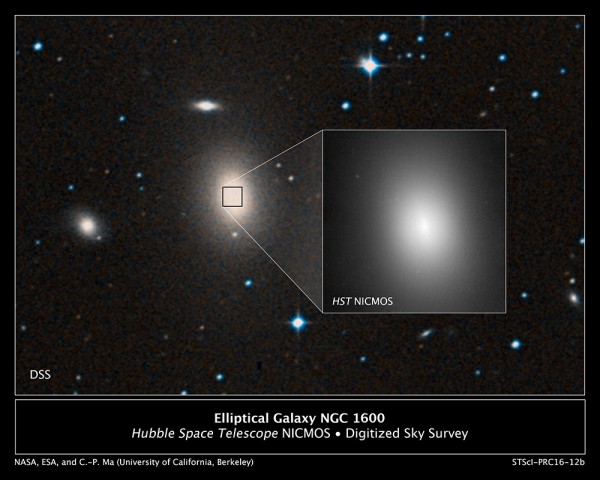By Ana Verayo, | April 07, 2016

A sky survey image of the massive galaxy NGC 1600, and a Hubble Space Telescope near-infrared closeup of the bright center of the galaxy where the 17-billion-solar-mass black hole — or binary black hole — resides.
A massive monster black hole has just been detected by astronomers that is estimated to be 17 billion times larger than the sun, which is oddly found inside a medium sized galaxy. This discovery is now making it even more clear how supermassive black holes could become a more common phenomena in the universe.
Like Us on Facebook
Black holes are usually composed of matter so dense that not even light energy or photons can escape its powerful gravitational forces. To date, the biggest black hole ever found is about 21 billion times more massive than the sun and compared to the black hole that is located at the core of the Milky Way, known as Sagittarius A, it is only about 4 million times bigger than our sun.
This newly found black hole however is located in this medium sized galaxy known as NGC 1600 which has been detected during a survey of the 100 most massive galaxies that are located some 300 million light years away from Earth.
According to co-author of the study, Chung-Pei Ma from the University of California Berkeley, it is quite possible that all these galaxies are host to black holes in their cores however, the question lies in measuring how big these black holes can get and if there are more denser ones similar to the one in NGC 1600.
Currently, we do not know if NGC 1600 is just the tip of an iceberg or just an extremely rare find or it could also be result from its violent, early stage, according to the team. Astronomers believe that NGC 1600's black hole is ten times more massive than the usual, in which a galaxy of this size can host.
Ma says that when it comes to the relationships of black holes between their host galaxies, the black hole's feeding habits during its existence can affect its location which means that nurture and nature are very crucial to the growth of these black holes.
Usually, these supermassive black holes comprise of 0.2 percent of its host galaxy's total mass, however, NGC 1600's black hole is significantly more dense than most black holes, at 2.1 percent of the entire galaxy's mass.
According to co-author of the study, Jens Thomas from The Max Planck Institute for Extraterrestrial Physics in Germany, another theory for this black hole's existence would be that NGC 1600 is a "fossil" system.
This would mean that compared to all the other average sized galaxy groups, which only contain a family of a handful supermassive galaxies, the NGC 1600 group is thought to form in a different manner, where the groups formed into one single massive galaxy in a short amount of time.
Astronomers also say that NGC 1600's environment is "empty" since it evolved so fast that its surroundings have been eaten by the black hole. It is also possible that NGC 1600's black hole is made of two black holes, since current data cannot confirm if it is a singlet or twin, says Ma.
This new study is published in the journal, Nature.
-
Use of Coronavirus Pandemic Drones Raises Privacy Concerns: Drones Spread Fear, Local Officials Say

-
Coronavirus Hampers The Delivery Of Lockheed Martin F-35 Stealth Fighters For 2020

-
Instagram Speeds Up Plans to Add Account Memorialization Feature Due to COVID-19 Deaths

-
NASA: Perseverance Plans to Bring 'Mars Rock' to Earth in 2031

-
600 Dead And 3,000 In The Hospital as Iranians Believed Drinking High-Concentrations of Alcohol Can Cure The Coronavirus

-
600 Dead And 3,000 In The Hospital as Iranians Believed Drinking High-Concentrations of Alcohol Can Cure The Coronavirus

-
COVID-19: Doctors, Nurses Use Virtual Reality to Learn New Skills in Treating Coronavirus Patients







